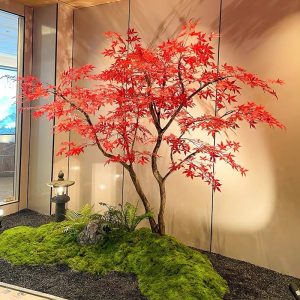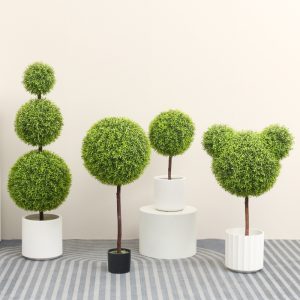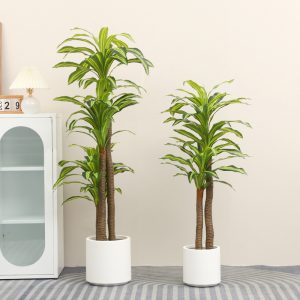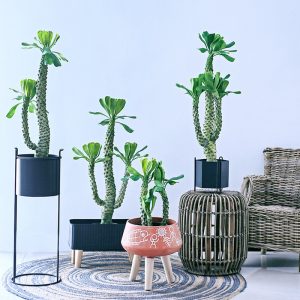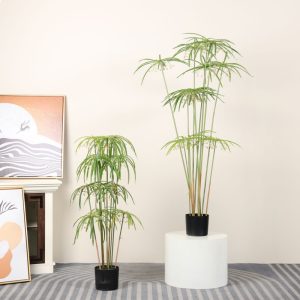At 10 a.m. in Barcelona, the early autumn sunlight streamed through the shutters of a Mediterranean restaurant in the old town, casting striped patterns on the blue-and-white tiled floor. I stood with the restaurant’s designer, Carlos, in the newly finished dining area, watching the waitress Maria gently brush the leaves of a green plant by the window. The feather-like fronds swayed lightly in the light.
“The texture of this areca palm is incredible,” Carlos said, unable to resist touching the leaves. The soft resilience beneath his fingertips surprised him. “During last week’s trial run, three regular guests asked if we had imported these from Morocco—none of them realized they were artificial.”
The restaurant was filled with the aroma of fresh olive oil and rosemary. In the four-meter-high space, several groups of artificial areca palm plants were placed along the dining area partitions. Near the bar stood one nearly two meters tall, with deep green feather-shaped leaves stretching gracefully from its sturdy trunk. The most striking feature was the semi-open private booth area, where a green wall of artificial areca palms was paired with silver ferns in woven planters, reflecting the glossy sheen of the foliage. These artificial areca palms for restaurants blended seamlessly into the space.

Light and Touch: The Spatial Expression of the Artificial Areca Palm
Walking through the dining area toward the terrace corridor, Carlos stopped suddenly at a nautical-themed decorative painting: “Look at the curled edge of this new leaf—the branching angle of the veins is identical to that of a real areca palm.” Up close, the leaf surface had a subtle waxy sheen, and the serrated edges felt natural to the touch. Under angled sunlight, the deep green leaves displayed a rich play of light and shadow.
The bar area design was equally thoughtful. In the space of a wooden bar counter paired with woven high stools, small potted artificial areca palms were placed every two meters. Their feather-like leaves glowed softly under the warm pendant lights. “After switching to these artificial plants, I no longer have to clean up fallen dry leaves every day,” said Javier, the bartender, as he gently rotated a pot. “The biggest surprise was customer feedback—many people say this touch of green makes the bar atmosphere better, and cocktail orders have even increased by 30%.”
In the private dining rooms during the afternoon, two medium-sized artificial areca palms spread their leaves beside a window-side round table. On closer look, the leaf veins on the underside were lighter than on the top, while the ring patterns on the stems were clearly visible, perfectly replicating the growth traits of real areca palms. “When we had real areca palms, the leaf tips would yellow after just three days of air conditioning,” explained waitress Anna. “These artificial areca palms don’t need watering, and their leaf spread is even more stable than the real ones.”
A Rational Choice: Why High-End Restaurants Prefer Artificial Areca Palms
“At first, when I suggested artificial plants, the owner almost rejected the idea,” Carlos recalled, stroking the leaf of a nearby areca palm. “He thought ‘fake plants’ would lower the restaurant’s image—until we ran a two-week comparison experiment.” He pointed to photos stored in the backroom: the real areca palm had curled leaves and tilted stems in the air-conditioned room; the ordinary artificial areca palm looked stiff, with shiny plastic under direct sunlight; but this premium high-polymer artificial areca palm kept its leaves spread naturally, and its color gradation looked even more authentic under different lighting.
Restaurant manager Lucia arrived with a maintenance log that revealed deeper advantages. In the dim hallway leading from the kitchen to the dining area, several artificial areca palms still retained their vibrant green color, unaffected by grease in the environment. “There’s no natural light here year-round. The real areca palms used to survive for at most three weeks,” she said, wiping a leaf with a tissue. “These restaurant artificial areca palms are treated with an anti-grease coating—just a damp cloth and they’re clean, which is crucial for hygiene standards.” She opened a cost sheet: since fully adopting artificial areca palm plants for restaurants, plant maintenance labor costs dropped by 70%, saving nearly €8,000 annually.
Procurement consultant Marta highlighted another critical point when showing a testing report: “For European and American restaurants, safety and durability are the bottom line.” She pointed to the food-grade certification, confirming that these artificial areca palms contain no formaldehyde or harmful substances. “Last week, a guest with a baby mentioned her child loved touching the ‘palm tree.’ She checked and found the leaf edges were smooth and rounded, so there was no risk of scratches,” Marta added.
From Dawn to Night: The All-Day Effect of Artificial Areca Palms in Restaurants
When night fell, warm golden pendant lights from the dome cast a golden edge onto the leaves of the artificial areca palms. “Guests love taking photos by these plants at night,” said night manager Pablo, showing me customer social media posts. Even under dim lighting, the silhouette of the areca palm remained vivid, without the plastic glare of ordinary artificial plants.
In the prep area at dawn, a small artificial areca palm in the corner still held its elegant posture. “Back when we used real areca palms, kitchen steam always wilted the leaves, and watering was risky around appliances,” said head chef Miguel, pointing at the leaf patterns. “Now, just glimpsing this green during work makes the team feel better.” For restaurants operating around the clock, the “tireless” resilience of the artificial areca palm meets space needs perfectly.
After a morning rain, I stood on the terrace looking at a set of artificial areca palms in clay pots. Raindrops slid naturally down the curved leaves. Isabella, a gardening enthusiast and frequent diner, snapped photos with her phone: “When real areca palms get rained on, the leaves often rot at the edges, but these artificial material leaves keep their firmness.” She smiled, saying she visits every week.
Beyond Decoration: The Emotional Value of the Artificial Areca Palm
Business traveler Emma asked about the plants at checkout: “My husband loves areca palms, but our home doesn’t have enough sunlight to keep them alive.” When she learned they were artificial plants, she immediately requested the supplier’s information. “During my meals here these past few days, every time I saw this green, I felt relaxed.” It was a “burden-free natural experience.”
Food blogger Lucas, filming a restaurant review, repeatedly zoomed in on the leaves of the artificial areca palms: “Followers always ask me about this restaurant’s vibe—the secret is these plants.” Adjusting his camera angle, he added, “Real plants wither and ruin the shot, but these artificial areca palms always look perfect.” Increasingly, restaurant owners are choosing artificial areca palm plants as their top choice.
During lunch on my last day, an elderly couple at the next table explained the plant to their granddaughter. The little girl reached out to touch the leaves. Sunlight filtered through the veins of the foliage.
The artificial areca palm is no longer just a decoration—it is part of the restaurant space, bringing the essence of a tropical jungle indoors, where its graceful feathered leaves become elements of design.








